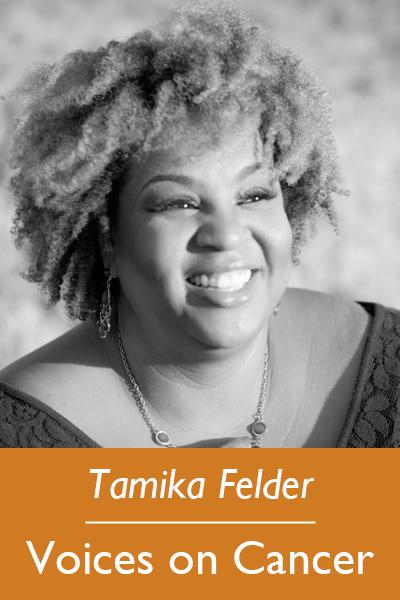
Voices on Cancer is an award-winning Cancer.Net Blog series where advocates share their stories and the lessons they have learned about being a cancer advocate. Tamika Felder is the founder of Cervivor, a nonprofit organization that brings the collective wisdom of cervical cancer survivors together to create a community of advocates. She’s committed to eradicating the stigma of cervical cancer’s link to the human papillomavirus (HPV) and sharing essential information about HPV, cervical cancer, and cervical cancer prevention.
My advocacy story
When I was diagnosed with cervical cancer, I never planned on becoming a patient advocate. In fact, it was the furthest thing from my mind. I was 25, single, childless, and scared. This was 2001 and no one was really talking about HPV, a virus often transmitted by sexual contact, that causes nearly all cervical cancers. I’d never even heard of it, and I pride myself with being “in the know.” I was even working on a national award-winning health show, and it wasn't a topic that we discussed.
As I healed from surgery and prepared for radiation therapy and chemotherapy, I still never thought about telling my story. It’s ironic because as a television producer, I am a glorified storyteller. But this wasn't a story that I wanted to share. I was ashamed and just wanted to put it all behind me.
So, I did. Or at least I thought I did. I slowly started pouring myself back into work and began the grind of networking and being the social butterfly who my friends and family have always loved.
But something was different. I was different. My life had forever been changed. As much as I tried to put the pieces of my cancer-riddled life back together, I just couldn't. The pieces no longer matched up. I didn't fit into my own world. My energy level wasn't the same, and I thought about my experience constantly.
It took me 3 years to accept that I had cancer and that it had rocked my perfectly planned future. But it happened and, thankfully, I survived. Now I had to live. And part of living my best life after cancer was doing something for those who would come after me. That meant helping them to never feel the isolation that I felt.
The more I got involved in the cancer community, the more the pieces of my life began to fit back together. But some of them took a new form, including me becoming a patient advocate.
When I first found the cervical cancer community, I only saw a handful of women sharing their stories—if that! I wondered why more women didn’t. Then I realized the reason was the same as my own: the stigma of having a disease linked to HPV. I saw a void that needed to be filled, so that’s where I sought to make a difference.
I saw a void that needed to be filled, so that’s where I sought to make a difference.
There are always people who think that “one voice doesn’t matter.” I learned that’s just not true. The voices of patient advocates are vital to every single aspect of the cancer community. We’re able to help bring forward new therapies and methods of communication, and even get policies changed. We need patient advocates to help conquer cancer. Patients need to work with clinicians, researchers, and policymakers.
We need to have a seat at the table because we complete the puzzle.
Sharing your story
Not sure what's holding you back from sharing your story? Feeling stuck? Here are a few helpful tips for finding your voice and getting started as a patient advocate:
-
Find the right fit. There are lots of organizations that need your voice. Finding the one that’s the right fit may feel overwhelming, so it can help to ask others for advice. Post on social media or email friends about wanting to get involved and see what suggestions they may have for you.
-
Figure out your availability. Most people want to give more than they can. Think realistically about your availability so you feel good about your commitment and don’t experience advocacy burnout.
-
Learn about legislation. Many people don’t realize that public policy advocacy at the state level can be the best place to create change. Get to know your state leaders. Attend their meet-and-greets and find out what committees they serve on. Let them know that they represent you and share your advocacy platform with them.
-
Get training. If you’re committed to becoming a patient advocate, training is necessary. Ask the organizations you’re most interested in working with about the training resources, programs, and conferences they provide or recommend.
